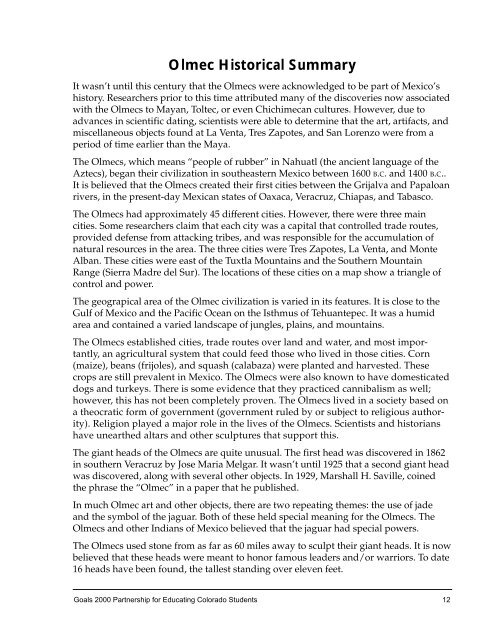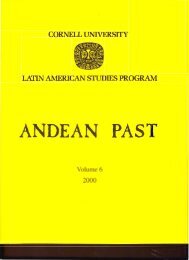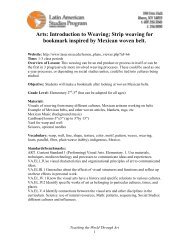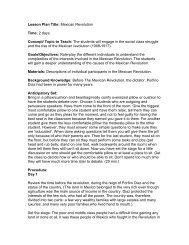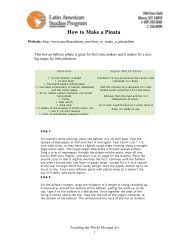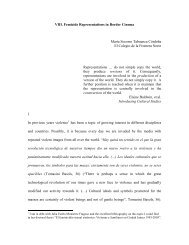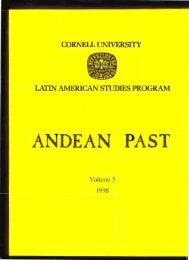The Mother Culture of Mexico: The Olmecs - Outreach World
The Mother Culture of Mexico: The Olmecs - Outreach World
The Mother Culture of Mexico: The Olmecs - Outreach World
You also want an ePaper? Increase the reach of your titles
YUMPU automatically turns print PDFs into web optimized ePapers that Google loves.
Olmec Historical Summary<br />
It wasn’t until this century that the <strong>Olmecs</strong> were acknowledged to be part <strong>of</strong> <strong>Mexico</strong>’s<br />
history. Researchers prior to this time attributed many <strong>of</strong> the discoveries now associated<br />
with the <strong>Olmecs</strong> to Mayan, Toltec, or even Chichimecan cultures. However, due to<br />
advances in scientific dating, scientists were able to determine that the art, artifacts, and<br />
miscellaneous objects found at La Venta, Tres Zapotes, and San Lorenzo were from a<br />
period <strong>of</strong> time earlier than the Maya.<br />
<strong>The</strong> <strong>Olmecs</strong>, which means “people <strong>of</strong> rubber” in Nahuatl (the ancient language <strong>of</strong> the<br />
Aztecs), began their civilization in southeastern <strong>Mexico</strong> between 1600 B.C. and 1400 B.C..<br />
It is believed that the <strong>Olmecs</strong> created their first cities between the Grijalva and Papaloan<br />
rivers, in the present-day Mexican states <strong>of</strong> Oaxaca, Veracruz, Chiapas, and Tabasco.<br />
<strong>The</strong> <strong>Olmecs</strong> had approximately 45 different cities. However, there were three main<br />
cities. Some researchers claim that each city was a capital that controlled trade routes,<br />
provided defense from attacking tribes, and was responsible for the accumulation <strong>of</strong><br />
natural resources in the area. <strong>The</strong> three cities were Tres Zapotes, La Venta, and Monte<br />
Alban. <strong>The</strong>se cities were east <strong>of</strong> the Tuxtla Mountains and the Southern Mountain<br />
Range (Sierra Madre del Sur). <strong>The</strong> locations <strong>of</strong> these cities on a map show a triangle <strong>of</strong><br />
control and power.<br />
<strong>The</strong> geograpical area <strong>of</strong> the Olmec civilization is varied in its features. It is close to the<br />
Gulf <strong>of</strong> <strong>Mexico</strong> and the Pacific Ocean on the Isthmus <strong>of</strong> Tehuantepec. It was a humid<br />
area and contained a varied landscape <strong>of</strong> jungles, plains, and mountains.<br />
<strong>The</strong> <strong>Olmecs</strong> established cities, trade routes over land and water, and most importantly,<br />
an agricultural system that could feed those who lived in those cities. Corn<br />
(maize), beans (frijoles), and squash (calabaza) were planted and harvested. <strong>The</strong>se<br />
crops are still prevalent in <strong>Mexico</strong>. <strong>The</strong> <strong>Olmecs</strong> were also known to have domesticated<br />
dogs and turkeys. <strong>The</strong>re is some evidence that they practiced cannibalism as well;<br />
however, this has not been completely proven. <strong>The</strong> <strong>Olmecs</strong> lived in a society based on<br />
a theocratic form <strong>of</strong> government (government ruled by or subject to religious authority).<br />
Religion played a major role in the lives <strong>of</strong> the <strong>Olmecs</strong>. Scientists and historians<br />
have unearthed altars and other sculptures that support this.<br />
<strong>The</strong> giant heads <strong>of</strong> the <strong>Olmecs</strong> are quite unusual. <strong>The</strong> first head was discovered in 1862<br />
in southern Veracruz by Jose Maria Melgar. It wasn’t until 1925 that a second giant head<br />
was discovered, along with several other objects. In 1929, Marshall H. Saville, coined<br />
the phrase the “Olmec” in a paper that he published.<br />
In much Olmec art and other objects, there are two repeating themes: the use <strong>of</strong> jade<br />
and the symbol <strong>of</strong> the jaguar. Both <strong>of</strong> these held special meaning for the <strong>Olmecs</strong>. <strong>The</strong><br />
<strong>Olmecs</strong> and other Indians <strong>of</strong> <strong>Mexico</strong> believed that the jaguar had special powers.<br />
<strong>The</strong> <strong>Olmecs</strong> used stone from as far as 60 miles away to sculpt their giant heads. It is now<br />
believed that these heads were meant to honor famous leaders and/or warriors. To date<br />
16 heads have been found, the tallest standing over eleven feet.<br />
Goals 2000 Partnership for Educating Colorado Students 12


